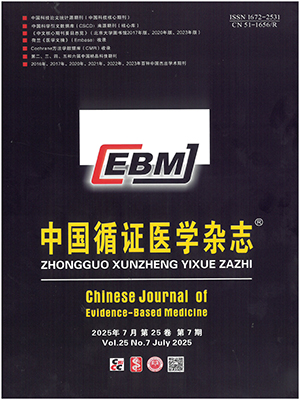| 1. |
赫捷, 陈万青. 2016中国肿瘤登记年报. 北京: 清华大学出版社, 2017.
|
| 2. |
Fan L, Strasserweippl K, Li JJ, et al. Breast cancer in China. Lancet Oncol, 2014, 15(7): e279-e289.
|
| 3. |
DeSantis CE, Ma J, Goding Sauer A, et al. Breast cancer statistics, 2017, racial disparity in mortality by state. CA Cancer J Clin, 2017, 67(6): 439-448.
|
| 4. |
Chen W, Zheng R, Baade PD, et al. Cancer statistics in China, 2015. CA Cancer J Clin, 2016, 66(2): 115-132.
|
| 5. |
赵亚太, 孙梅. 青岛市单中心乳腺癌风险预测模型的研究. 临床检验杂志(电子版), 2019, 8(2): 87.
|
| 6. |
董华, 马岚. 基于机器学习的三阴乳腺癌预测模型. 云南大学学报(自然科学版), 2017, (S1): 111-115.
|
| 7. |
Zhang L, Jie Z, Xu S, et al. Use of receiver operating characteristic (roc) curve analysis for tyrer-cuzick and gail in breast cancer screening in Jiangxi province, China. Med Sci Monit, 2018, 24: 5528-5532.
|
| 8. |
安丽营, 张开治, 张英丽, 等. Gail和Cuzick-Tyrer乳腺癌风险评估模型应用的初探. 中国妇幼保健, 2016, 31(5): 945-946.
|
| 9. |
Novotny J, Pecen L, Petruzelka L, et al. Breast cancer risk assessment in the Czech female population-an adjustment of the original Gail model. Breast Cancer Res Treat, 2006, 95(1): 29-35.
|
| 10. |
Newman LA. Applicability of the Gail model for breast cancer risk assessment in Turkish female population and evaluation of breastfeeding as a risk factor. Breast Cancer Res Treat, 2010, 120(2): 425-426.10.
|
| 11. |
Bondy ML, Newman LA. Breast cancer risk assessment models: applicability to African-American women. Cancer, 2003, 97(1 Suppl): 230-235.
|
| 12. |
Merajver SD, Milliron K. Breast cancer risk assessment: a guide for clinicians using the NCCN Breast Cancer Risk Reduction Guidelines. J Natl Compr Canc Netw, 2003, 1(2): 297-301.
|
| 13. |
王春亭. Gail乳腺癌模型应用价值及乳腺导管内乳头状肿瘤良恶性危险因素研究. 济南: 山东大学, 2017.
|
| 14. |
周建军, 王烨菁, 高淑娜, 等. Gail乳腺癌风险评估模型的应用价值初探. 上海预防医学, 2014, 26(5): 236-238.
|
| 15. |
杜沛玲. 潮汕地区女性乳腺癌相关因素及风险评估模型. 汕头: 汕头大学, 2017.
|
| 16. |
胡建英. Gail乳腺癌风险评估模型在浙东沿海地区妇女中的适用性研究. 杭州: 浙江大学, 2015.
|
| 17. |
Cao W, Wang X, Li JC. Hereditary breast cancer in the Han Chinese population. J Epidemiol, 2013, 23(2): 75-84.
|
| 18. |
Petracci E, Decarli A, Schairer C, et al. Risk factor modification and projections of absolute breast cancer risk. J Natl Cancer Inst, 2011, 103(13): 1037-1048.
|
| 19. |
卫生部统计信息中心. 2014中国卫生和计划生育统计年鉴. 北京: 中国协和医科大学出版社, 2014.
|
| 20. |
Bruzzi P, Green SB, Byar DP, et al. Estimating the population attributable risk for multiple risk factors using case-control data. Am J Epidemiol, 1985, 122(5): 904-914.
|
| 21. |
恽振先. 多因素人群归因危险度估计及其计算程序. 中国卫生统计, 1993, 10(5): 53-55.
|
| 22. |
Winters S, Martin C, Murphy D, et al. Breast cancer epidemiology, prevention, and screening. Prog Mol Biol Transl Sci, 2017, 151: 1-32.
|
| 23. |
Hilton HN, Clarke CL, Graham JD. Estrogen and progesterone signalling in the normal breast and its implications for cancer development. Mol Cell Endocrinol, 2018, 466: 2-14.
|
| 24. |
Khalis M, Charbotel B, Chajès V, et al. Menstrual and reproductive factors and risk of breast cancer: a case-control study in the Fez region, Morocco. PLoS One, 2018, 13(1): e0191333.
|
| 25. |
Rajbongshi N, Mahanta LB, Nath DC, et al. A matched case control study of risk indicators of breast cancer in Assam, India. Mymensingh Med J, 2015, 24(2): 385-391.
|
| 26. |
Lambe M, Hsieh C, Trichopoulos D, et al. Transient increase in the risk of breast cancer after giving birth. N Engl J Med, 1994, 331(1): 5-9.
|
| 27. |
Albrektsen G, Heuch I, Thoresen S, et al. Family history of breast cancer and short-term effects of childbirths on breast cancer risk. Int J Cancer, 2006, 119(6): 1468-1474.
|
| 28. |
何丹丹, 吴菲, 温晓飒, 等. Gail乳腺癌风险评估模型的研究进展. 肿瘤, 2016, 36(12): 1389-1394.
|
| 29. |
Crispo A, D'Aiuto G, De Marco M, et al. Gail model risk factors: impact of adding an extended family history for breast cancer. Breast J, 2008, 14(3): 221-227.
|
| 30. |
Dai J, Hu Z, Jiang Y, et al. Breast cancer risk assessment with five independent genetic variants and two risk factors in Chinese women. Breast Cancer Res, 2012, 14(1): R17.
|
| 31. |
吴菲, 何丹丹, 赵根明, 等. 上海市女性乳腺癌危险因素分析与风险预测模型研究. 中华肿瘤防治杂志, 2017, 24(12): 795-801, 807.
|
| 32. |
帅健, 李丽萍, 陈业群. 决策树模型与Logistic回归模型在伤害发生影响因素分析中的作用. 中华疾病控制杂志, 2015, 19(2): 185-189.
|




